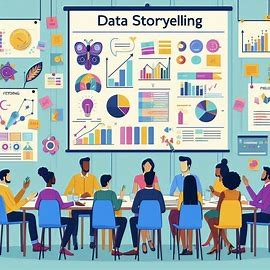Demystifying Data: The Power of Data Storytelling
Introduction
Data analytics has evolved from a niche field to a cornerstone of decision-making across industries. While numbers and statistics are essential, the real magic lies in transforming raw data into compelling narratives. Data storytelling is the art of communicating complex insights in a way that resonates with your audience, whether they’re seasoned analysts or business leaders.
The Importance of Data Storytelling
- Enhanced Decision Making: Stories make information more memorable and actionable, leading to better-informed decisions.
- Improved Communication: Complex data can be simplified and communicated effectively, fostering collaboration.
- Increased Engagement: By connecting with the audience on an emotional level, data storytelling drives impact.
Key Elements of Effective Data Storytelling
- Know Your Audience: Understand their background, interests, and goals to tailor your story accordingly.
- Identify a Compelling Narrative: Find the underlying story in your data. What’s the main message you want to convey?
- Choose the Right Visuals: Select charts, graphs, and images that complement your story and enhance understanding.
- Use Clear and Concise Language: Avoid jargon and technical terms that might confuse your audience.
- Practice and Refine: Storytelling is a skill that improves with practice. Seek feedback and iterate on your approach.
Real-World Examples of Data Storytelling
- Business: A marketing team uses data to demonstrate the impact of a new campaign on customer acquisition and retention.
- Healthcare: A researcher tells the story of how data-driven insights led to the development of a life-saving treatment.
- Social Impact: A non-profit organization uses data to highlight the challenges faced by a community and advocate for change.
Tools and Techniques
- Data Visualization: Tools like Tableau, Power BI, and Python libraries (Matplotlib, Seaborn) can create stunning visuals.
- Narrative Building: Consider using storytelling frameworks like the Hero’s Journey or the Freytag Pyramid.
- Interactive Storytelling: Platforms like Tableau and Looker allow for interactive exploration of data.
Conclusion
Data storytelling is a powerful tool that can transform how we perceive and use information. By mastering the art of weaving data into compelling narratives, you can influence decisions, inspire action, and drive positive change.
Would you like to explore a specific data storytelling technique or industry application in more detail?

Leave a Reply